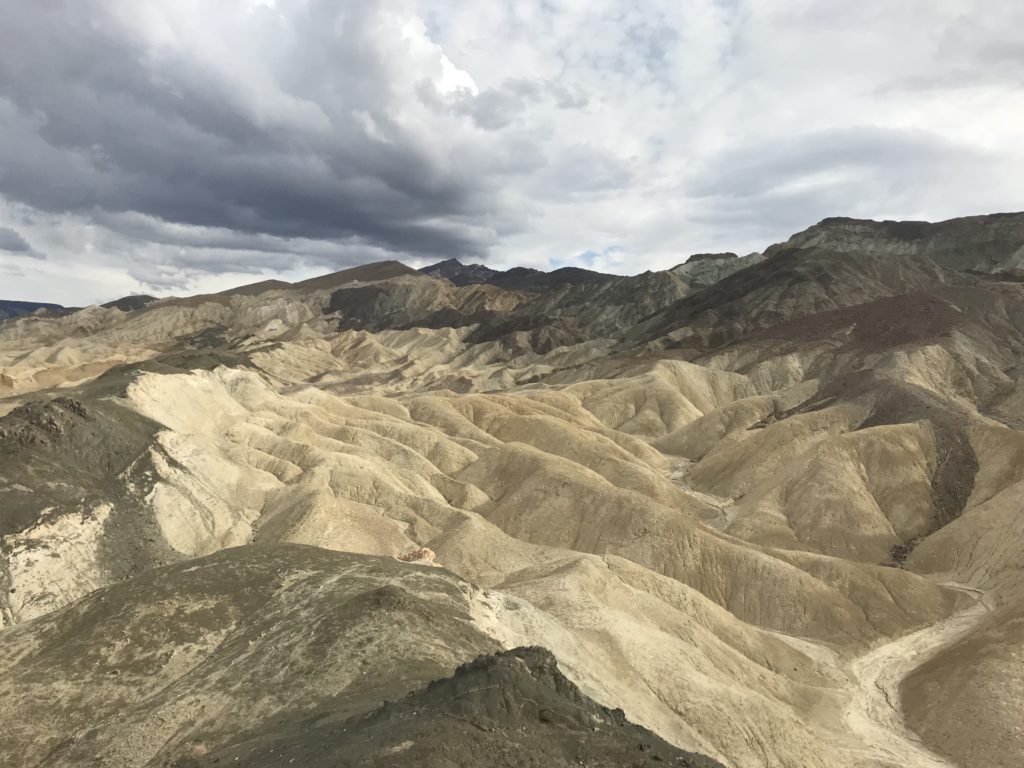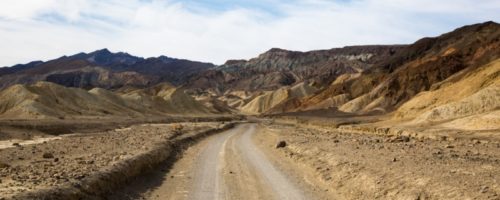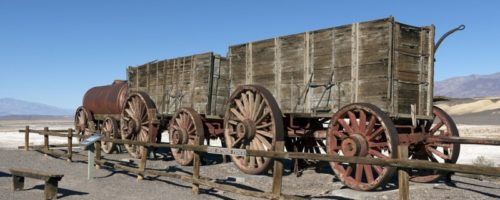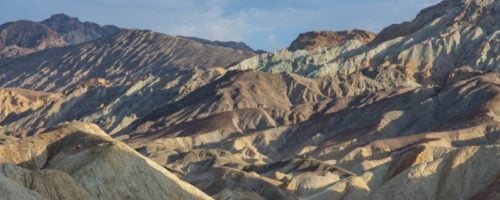
Twenty Mule Team Canyon
General Description
Death Valley National Park is well known for its rich mining past. The 20 mule teams and wagons that once carried tons of borax through this unforgiving landscape are an enduring legacy. 20 Mule Team Canyon was heavily prospected for borax around the turn of the twentieth century leaving behind countless loading platforms, mine tailings, and tunnels. The scenic drive through this incredible canyon offers tons of hiking potential in the richly colored badlands of the Black Mountains. Take your pick of any number of short hikes through networks of canyons and ridges along the drive. There are no official trails, so choose your adventure wisely. The badland hills along this drive are teeming with discovery and just begging to be explored. Take this hike in the early morning or late afternoon to see a dazzling display of light and shadow.
Explore Death Valley with Expert Guides
Getting to Twenty Mule Team Canyon
From the Furnace Creek Visitor Center, drive 6 miles east on CA 190. The entrance to the one-way Twenty Mule Team Canyon Drive will be on the right. If you are entering the park from the east, the entrance will be on the left 24.5 miles from Death Valley Junction and the Amargosa Opera House. From this approach, the entrance is 1.6 miles beyond the exit.
Fun Facts
- The Twenty Mule Teams were only in operation for six years from 1883-1889. The Harmony Borax Works and Amargosa Borax Works shut down in 1888 ceasing the need for the teams.
- Each wagon was 16 feet long and 6 feet deep, made of solid oak and weighed 7800 pounds when empty.
- The wagons were designed to carry 9 metric tons of ore.
- The rear wagon wheels were 7 feet in diameter with one inch thick iron tires.
- The full wagon train weighed in excess of 73,000 pounds!
- The entire caravan of mules, wagons, and water tank measured nearly 100 feet long.
- Not a single wagon ever broke down in transit.
- It took 10 days to make the 165 mile one-way trip from Death Valley to Mojave, CA.
- More than 20 million pounds of borax were hauled out of Death Valley during the Twenty Mule Team’s operation.
- The Twenty Mule Teams made their appearance to the world at the St. Louis World’s Fair, the same year that Frederick Dellenbaugh was to introduce the world to Zion Canyon.
- There were only 18 mules in each team. 2 horses were hitched closest to the wagon to steer the heavy loads.

3 Best Day Hikes Near Twenty Mule Team Canyon
After exploring the spectacular Twenty Mule Team Canyon, check out these other nearby trails and make the most of your visit to Death Valley
| Destination | Miles | Elev | Difficulty | Style | |
| Golden Canyon | 2.5-4.5 mi | 700 ft | Easy-Moderate | Out and Back | |
| Desolation Canyon | 3.5 mi | 750 ft | Moderate | Out and Back | |
| Badwater Basin | N/A | 0 ft | Easy | Out and Back |
1. Golden Canyon
Golden Canyon is a must-do hike on any visit to Death Valley National Park. This tangled system of canyons cuts through brilliant yellow-gold badlands where secrets and adventures lurk around every corner. Other trails in the area to Red Cathedral, Zabriskie Point, and Gower Gulch make this a real choose your own adventure hike. Take a short hike to the towering fluted red walls of Red Cathedral. Want to hike point to point? Why not take the downhill route from Zabriskie Point? Have a bigger, off the beaten path adventure in mind? Take the spur trail to Gower Gulch and scramble the smoothly polished dry falls of its narrows. Whatever size of adventure you’d like, Golden Canyon has something that will fit the bill.
2. Desolation Canyon
If you’re looking for a top-notch entry level cross country trail, Desolation Canyon comes in at the top of the class. Far less popular than nearby Golden Canyon and Gower Gulch, Desolation Canyon is a family-friendly, fun-filled, route finding hike. Trek cross country picking your entry into the shallow wash that will soon rise around you into a beautiful wineglass shaped canyon. Not long after the walls close in, hikers are faced with a few short dry fall scrambles to rouse that intrepid spirit. As a reward for your effort, the canyon puts on display stunning pinks, reds, purples, blues, and greens, reminiscent of the nearby Artist’s Palette. Take a little time to explore some of Desolation’s many short side canyons. The pinnacle of the hike is a ridgetop view of Artist Drive and sweeping Death Valley vistas. Desolation Canyon is sure to charge up your sense of adventure.
3. Badwater Basin
The high point of any trip to Death Valley National Park just might be a visit to the lowest place in North America, Badwater Basin. From 280 feet below sea level, park visitors can stroll out onto an endless pan of glowing white salt. Telescope Peak looms 11,000 above Badwater Basin to the southwest and Dante’s View, just over a vertical mile straight up to the east. There’s more to appreciate than just the immensity of the landscape. Further out on the salt flats, away from trampling feet are salt crystal polygons as unique and numerous as snowflakes in a blizzard. Badwater Basin has no defined trail, so explore to your heart’s content. Just be aware that the fragile salt pools are off-limits to everyone. Be sure to carry plenty of water and enjoy this iconic wonder of Death Valley.
Maximize Your Visit to Death Valley National Park on a Hiking Tour
Guided multi-day packages allow visitors the opportunity to make the most of their time in Death Valley National Park and to do it hassle-free. Guided tours include gear (backpack, trekking poles, crampons in winter), meals, accommodations, local transportation, and a professional Death Valley hiking guide. Through their knowledge, stories, and personal passion, guides can bring a place to life in a way that’s much more difficult to do on your own. Read more about Death Valley Hiking Tours.
Award Winning USA Hiking Vacations

Join a Guided Death Valley National Park Backpacking Trip
Joining a Death Valley backpacking tour is a worry-free, adventurous way to experience Death Valley National Park. With your gear, meals, local transportation, permits, and fees taken care of for you, you can travel light and focus 100% on enjoying the hiking experience, while the guide company takes care of everything else. Also, by going with local experts you’ll enjoy a greater level of safety and gain a much better understanding of the history and ecology of this remarkable region. Read more about a guided Death Valley National Park backpacking trip.

When to Hike and Seasonal Considerations
Twenty Mule Team Canyon is best hiked from late fall to early spring. Like many of Death Valley’s hikes, there is very little shade and summertime temperatures often exceed triple digits. Check road and weather conditions before you go, as Twenty Mule Team Canyon Road is subject to flooding during rain events. The road is generally passable by high clearance vehicles.
Necessary Permits
Day Hikes
No permits are required for day hiking in Death Valley National Park.
Backpacking Permits
Backcountry camping permits are voluntary and may be obtained at the Visitor Center or any Ranger Station. Due to the extreme environment and remoteness, it is recommended that solo hikers and backpackers provide itinerary information and emergency contacts to park personnel.
Suggested Packing List
Day Hike Packing List
- 3-4 liters of water per person
- Salty, calorie-rich snacks
- lunch
- backpack
- trekking poles
- crampons (in winter)
- wide-brimmed hat
- sunscreen, sunglasses
- cotton t-shirt (spring-fall)
- non-cotton t-shirt (winter)
- rain jacket
- warm non-cotton layer
- 1st-aid kit
Backpacking Packing List
- all items listed for day hikes PLUS
- additional water AND water filter/purification method
- multi-day backpack
- 3-season tent
- sleeping bag
- sleeping pad
- backpacking stove and fuel
- backpacking meals
- 2-3 pairs wool socks
- extra t-shirts
Please Respect Our National Parks – Leave No Trace
We strongly recommend abiding by all Leave No Trace ethics guidelines and practices so that our national parks and public lands are preserved for the enjoyment of future generations and for the people and animals who call these places home. Simple things like packing out your trash, obeying national park rules, and respecting the peace and quiet of our national park trails is a great start. If you’re going on a backpacking trip, you can read about more about the 7 Leave No Trace Principles.




